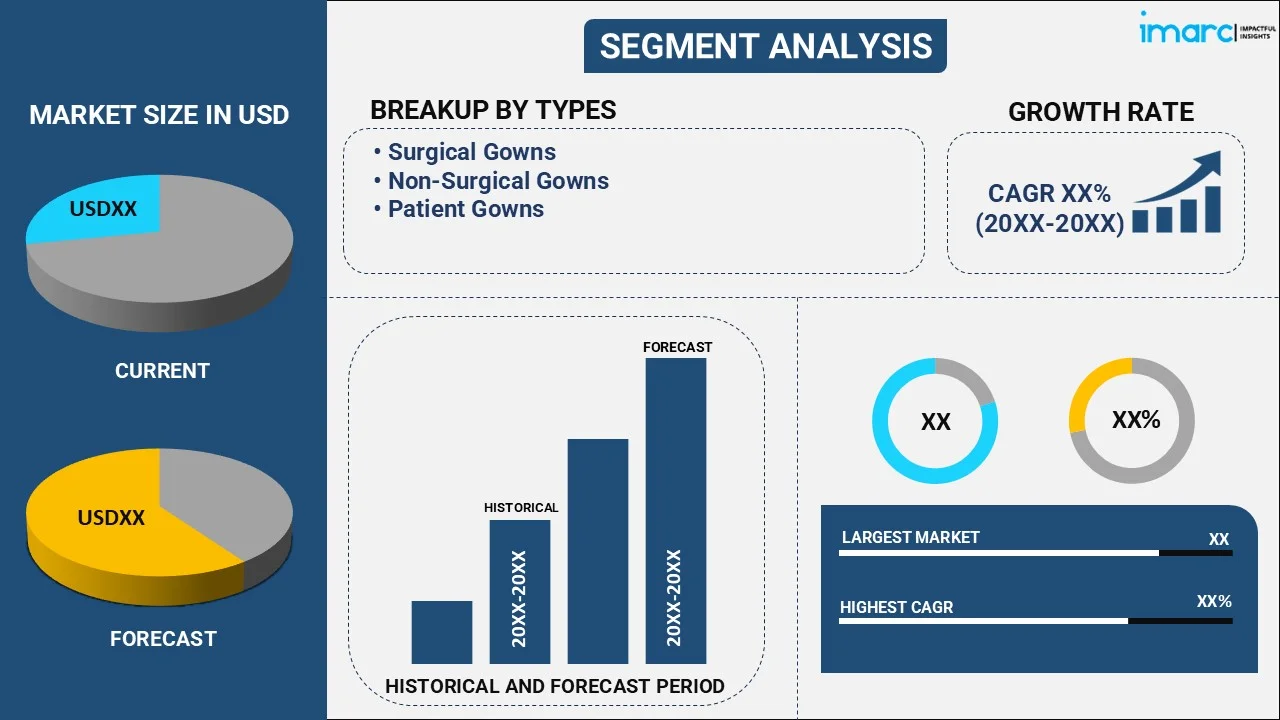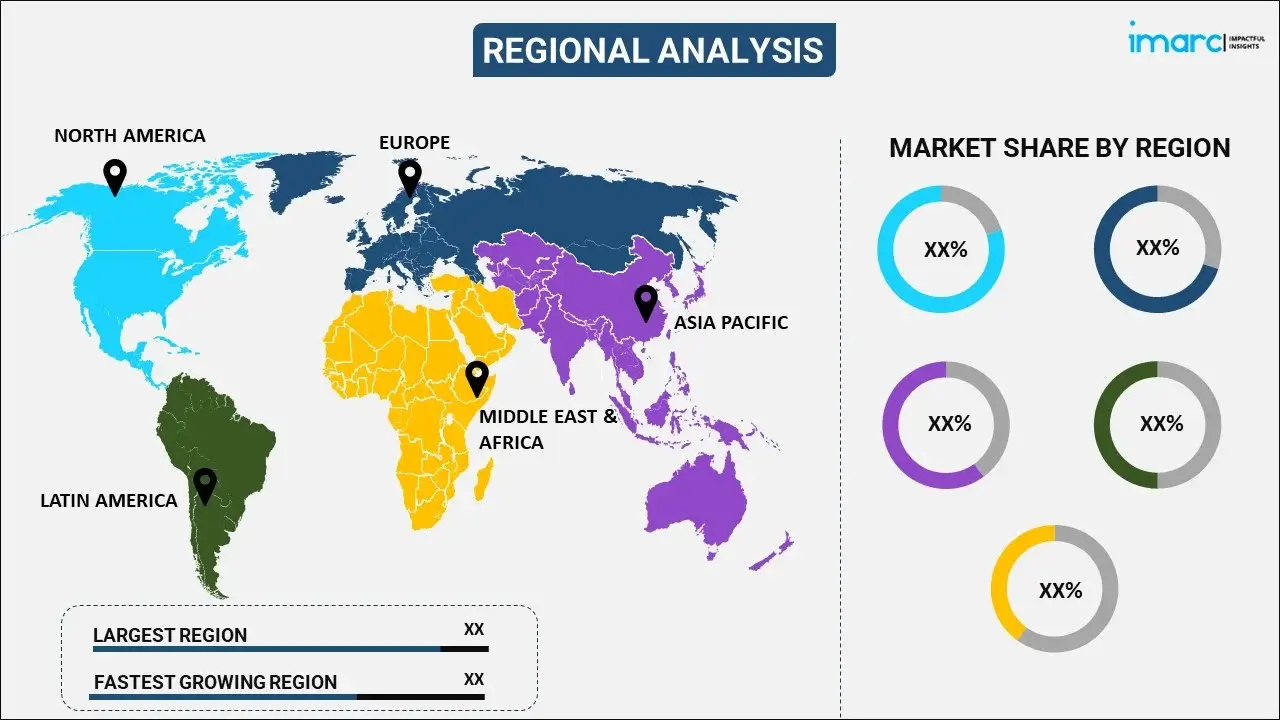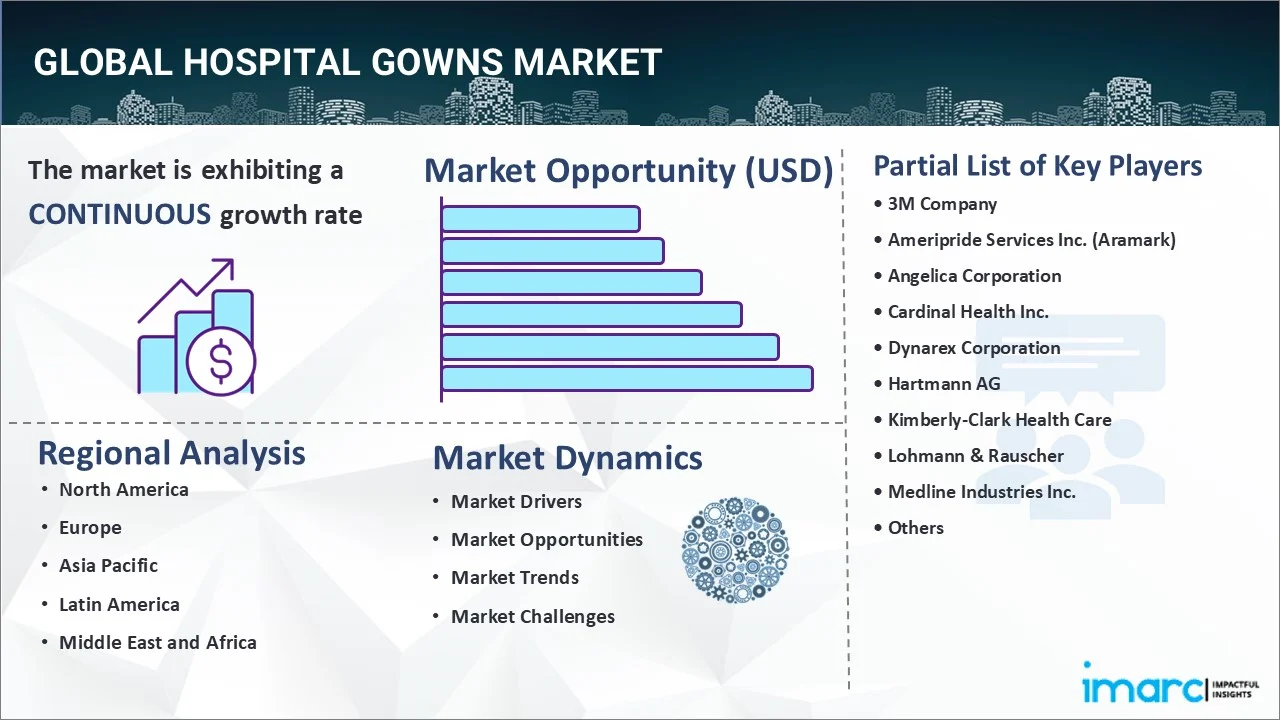
Hospital Gowns Market Report by Type (Surgical Gowns, Non-Surgical Gowns, Patient Gowns), Risk Type (Minimal, Low, Moderate, High), Usability (Disposable, Reusable), and Region 2025-2033
Hospital Gowns Market Size:
The global hospital gowns market size reached USD 5.2 Billion in 2024. Looking forward, IMARC Group expects the market to reach USD 13.3 Billion by 2033, exhibiting a growth rate (CAGR) of 10.32% during 2025-2033. The market is driven by the implementation of stringent regulatory standards, increasing demand for infection control, ongoing advancements in medical textiles, rising healthcare expenditures, enhanced protective features, and the heightening need for high-quality, reliable gowns in medical procedures.
|
Report Attribute
|
Key Statistics
|
|---|---|
|
Base Year
|
2024 |
|
Forecast Years
|
2025-2033
|
|
Historical Years
|
2019-2024
|
| Market Size in 2024 | USD 5.2 Billion |
| Market Forecast in 2033 | USD 13.3 Billion |
| Market Growth Rate (2025-2033) | 10.32% |
Hospital Gowns Market Analysis:
- Major Market Drivers: The hospital gowns market is primarily driven by the increasing incidence of hospital-acquired infections (HAIs), necessitating strict hygiene protocols. The rising number of surgeries and extended hospital stays due to chronic diseases also fuel demand. Technological advancements in fabric materials, offering enhanced protection and comfort, further propel market growth. Additionally, the global aging population and the consequent rise in healthcare services create a consistent need for hospital gowns.
- Key Market Trends: One of the key trends in the hospital gowns market is the shift toward disposable gowns due to their convenience and superior infection control. There is also a growing preference for antimicrobial and fluid-resistant materials to enhance patient and staff safety. Sustainable and eco-friendly gown options are gaining traction as hospitals seek to reduce their environmental footprint. Customization and improved designs for better fit and comfort are becoming increasingly popular as well.
- Geographical Trends: North America holds the largest segment in the hospital gowns market, driven by a robust healthcare infrastructure, high healthcare spending, and stringent infection control regulations. The presence of key market players and ongoing technological advancements in medical textiles also contribute to this dominance. Additionally, the rising prevalence of chronic diseases and an aging population in the region ensure a steady demand for hospital gowns. The strong emphasis on patient safety and hygiene standards further supports market growth in North America.
- Competitive Landscape: Some of the major market players in the hospital gowns industry include 3M Company, Ameripride Services Inc. (Aramark), Angelica Corporation, Cardinal Health Inc., Dynarex Corporation, Hartmann AG, Kimberly-Clark Health Care, Lohmann & Rauscher, Medline Industries Inc., Priontex, Stryker Corporation, Standard Textile Co. Inc., etc., among many others.
- Challenges and Opportunities: Challenges in the hospital gowns market include managing costs while maintaining quality and ensuring a steady supply chain amidst global disruptions. Environmental concerns regarding disposable gowns also pose a challenge. However, these challenges present opportunities for innovation, such as developing cost-effective, high-quality reusable gowns and advancing sustainable materials. Expanding healthcare infrastructure in emerging markets offers significant growth opportunities, as does increasing awareness of infection control and patient safety globally.
Hospital Gowns Market Trends:
Increasing Regulatory Standards
The hospital gowns market is significantly influenced by increasing regulatory standards aimed at ensuring the safety and efficacy of medical gowns. The FDA classifies medical gowns into various levels based on their protective capabilities, ranging from minimal risk (Level 1) to high-risk (Level 4) scenarios. For example, Level 4 gowns are required in surgeries and high-risk infectious disease scenarios, offering the highest level of barrier protection. The United States Food and Drug Administration’s (USFDA's) stringent guidelines for premarket notification (510(k)) ensure that gowns meet safety standards before they are marketed, enhancing the overall quality of protective apparel used in healthcare settings. This emphasis on regulation is crucial for protecting healthcare workers and patients, reducing the risk of contamination and infection during medical procedures.
Adoption of Sustainable Practices
A growing trend in the hospital gowns market is the adoption of sustainable practices. Hospitals and healthcare facilities are increasingly looking for eco-friendly alternatives to traditional disposable gowns. This shift is driven by the need to reduce medical waste and the environmental impact of healthcare operations. For instance, reusable gowns made from high-quality, durable materials can be laundered and sterilized for multiple uses, aligning with sustainability goals. According to the Centers for Medicare & Medicaid Services (CMS), healthcare facilities are also focusing on cost-effective solutions that do not compromise on protection and safety standards. This trend reflects a broader movement toward sustainability in the healthcare industry, promoting environmental responsibility while maintaining high levels of patient care.
Market Growth and Innovation
The hospital gowns market is experiencing significant growth and innovation, driven by the increasing demand for advanced protective apparel. The coronavirus (COVID-19) pandemic highlighted the critical need for high-quality medical gowns, spurring innovation in materials and design. The market is projected to expand further as manufacturers introduce gowns with enhanced protective features, such as fluid resistance and breathability, to meet the diverse needs of healthcare providers. According to CMS data, the market basket update for FY 2024 reflects an increase, indicating positive growth trends. This growth is supported by continuous advancements in textile technology and the development of new gown types tailored to specific medical environments, enhancing both functionality and comfort for healthcare workers.
Hospital Gowns Market Segmentation:
IMARC Group provides an analysis of the key trends in each segment of the market, along with forecasts at the global, regional, and country levels for 2025-2033. Our report has categorized the market based on type, risk type, and usability.
Breakup by Type:

- Surgical Gowns
- Non-Surgical Gowns
- Patient Gowns
Surgical gowns accounts for the majority of the market share
The report has provided a detailed breakup and analysis of the market based on the type. This includes surgical gowns, non-surgical gowns, and patient gowns. According to the report, surgical gowns represented the largest segment.
Surgical gowns are the largest segment by type in the hospital gowns market due to their critical role in protecting both healthcare workers and patients during surgical procedures. These gowns provide the highest level of barrier protection against microorganisms, body fluids, and particulate matter, making them essential in preventing infections. The FDA classifies surgical gowns as Class II medical devices, requiring rigorous premarket notification and compliance with established safety standards. The increased adoption of surgical procedures globally and the stringent regulatory requirements for infection control contribute significantly to the dominance of this segment. According to the Centers for Medicare & Medicaid Services (CMS), healthcare facilities continually invest in high-quality surgical gowns to ensure safety and compliance, reflecting the segment's importance.
Breakup by Risk Type:
- Minimal
- Low
- Moderate
- High
High risk holds the largest share of the industry
A detailed breakup and analysis of the market based on the risk type have also been provided in the report. This includes minimal, low, moderate, and high. According to the report, high risk accounted for the largest market share.
High-risk surgical gowns are the largest segment by risk type in the hospital gowns market due to their critical role in high-stakes medical environments. These gowns are essential for protecting healthcare personnel during long, fluid-intensive procedures and surgeries where pathogen resistance is crucial. The FDA categorizes these gowns as providing the highest level of barrier protection, necessary for high-risk situations involving infectious diseases and significant fluid exposure. The stringent regulatory requirements and the increasing prevalence of complex surgical procedures drive the demand for high-risk surgical gowns. According to the Centers for Medicare & Medicaid Services (CMS), hospitals invest significantly in these high-protection gowns to comply with safety standards and ensure optimal patient and staff safety.
Breakup by Usability:
- Disposable
- Reusable
Disposable represents the leading market segment
The report has provided a detailed breakup and analysis of the market based on the usability. This includes disposable and reusable. According to the report, disposable represented the largest segment.
Disposable gowns are the largest segment by reusability in the hospital gowns market due to their convenience, cost-effectiveness, and reduced risk of cross-contamination. These single-use gowns are essential in maintaining high hygiene standards as they eliminate the need for laundering and potential reuse errors. The demand for disposable gowns surged during the coronavirus (COVID-19) pandemic, highlighting their importance in preventing the spread of infections. According to the FDA, medical gowns are examples of personal protective equipment used in health care settings. The ease of use and compliance with infection control protocols make disposable gowns a preferred choice in many healthcare facilities.
Breakup by Region:

- North America
- United States
- Canada
- Asia-Pacific
- China
- Japan
- India
- South Korea
- Australia
- Indonesia
- Others
- Europe
- Germany
- France
- United Kingdom
- Italy
- Spain
- Russia
- Others
- Latin America
- Brazil
- Mexico
- Others
- Middle East and Africa
North America leads the market, accounting for the largest hospital gowns market share
The report has also provided a comprehensive analysis of all the major regional markets, which include North America (the United States and Canada); Asia Pacific (China, Japan, India, South Korea, Australia, Indonesia, and others); Europe (Germany, France, the United Kingdom, Italy, Spain, Russia, and others); Latin America (Brazil, Mexico, and others); and the Middle East and Africa. According to the report, North America was the largest regional market for hospital gowns.
North America is the largest segment by region in the hospital gowns market due to its advanced healthcare infrastructure, high healthcare spending, and stringent regulatory standards. The region's robust healthcare system ensures a consistent demand for high-quality medical gowns. Additionally, key market players and ongoing technological advancements contribute to market growth. CMS projects Medicare disproportionate share hospital (DSH) payments and Medicare uncompensated care payments combined will decrease in FY 2024 by approximately $957 million, reflecting a significant investment in healthcare resources and protective equipment. This substantial spending, combined with a strong focus on infection control and patient safety, drives the demand for hospital gowns, making North America the leading market.
Competitive Landscape:
- The market research report has also provided a comprehensive analysis of the competitive landscape in the market. Detailed profiles of all major companies have also been provided. Some of the major market players in the hospital gowns industry include 3M Company, Ameripride Services Inc. (Aramark), Angelica Corporation, Cardinal Health Inc., Dynarex Corporation, Hartmann AG, Kimberly-Clark Health Care, Lohmann & Rauscher, Medline Industries Inc., Priontex, Stryker Corporation, Standard Textile Co. Inc., etc.
(Please note that this is only a partial list of the key players, and the complete list is provided in the report.)
- The competitive landscape of the hospital gowns market is characterized by the presence of several key players, such as Medline Industries, Inc., Cardinal Health, and Standard Textile Co., Inc., who dominate through extensive product portfolios and innovative solutions. Companies are focusing on enhancing product features, such as incorporating antimicrobial properties and using eco-friendly materials, to gain a competitive edge. For instance, Medline Industries Inc. recently launched a new line of SMS fabric made from recycled materials, emphasizing sustainability without compromising on protection and comfort. Additionally, strategic collaborations and mergers are common as companies seek to expand their market presence and leverage advanced technologies to meet the evolving demands of the healthcare sector.
Hospital Gowns Market News:
- 24 Aril 2024, A new patient wear brand which features sustainable, functional, and cost-effective hospital gowns and recovery wear to improve patient experience has been developed by a graduate from the University’s Manchester Fashion Institute. Since graduating from BA (Hons) Fashion and Business Management in 2023, Olivia Burns has been developing her business Hypoplas, an innovative patient wear brand that creates comfortable and stylish clothing for patients.
- In March 2024, Children’s Minnesota expands inclusive patient clothing with modest hospital gowns. To ensure inclusive and culturally-sensitive care for all pediatric patients, The Kid Experts® and Henna & Hijabs – a Minnesota-based and Black-, Muslim-, woman-led company, are joining together to embark on a new frontier, a new modest pediatric hospital gown.
Hospital Gowns Market Report Scope:
| Report Features | Details |
|---|---|
| Base Year of the Analysis | 2024 |
| Historical Period | 2019-2024 |
| Forecast Period | 2025-2033 |
| Units | Billion USD |
| Scope of the Report | Exploration of Historical Trends and Market Outlook, Industry Catalysts and Challenges, Segment-Wise Historical and Future Market Assessment:
|
| Types Covered | Surgical Gowns, Non-Surgical Gowns, Patient Gowns |
| Risk Types Covered | Minimal, Low, Moderate, High |
| Usabilities Covered | Disposable, Reusable |
| Regions Covered | Asia Pacific, Europe, North America, Latin America, Middle East and Africa |
| Countries Covered | United States, Canada, Germany, France, United Kingdom, Italy, Spain, Russia, China, Japan, India, South Korea, Australia, Indonesia, Brazil, Mexico |
| Companies Covered | 3M Company, Ameripride Services Inc. (Aramark), Angelica Corporation, Cardinal Health Inc., Dynarex Corporation, Hartmann AG, Kimberly-Clark Health Care, Lohmann & Rauscher, Medline Industries Inc., Priontex, Stryker Corporation, Standard Textile Co. Inc., etc. |
| Customization Scope | 10% Free Customization |
| Post-Sale Analyst Support | 10-12 Weeks |
| Delivery Format | PDF and Excel through Email (We can also provide the editable version of the report in PPT/Word format on special request) |
Key Questions Answered in This Report:
- How has the global hospital gowns market performed so far, and how will it perform in the coming years?
- What are the drivers, restraints, and opportunities in the global hospital gowns market?
- What is the impact of each driver, restraint, and opportunity on the global hospital gowns market?
- What are the key regional markets?
- Which countries represent the most attractive hospital gowns market?
- What is the breakup of the market based on the type?
- Which is the most attractive type in the hospital gowns market?
- What is the breakup of the market based on the risk type?
- Which is the most attractive risk type in the hospital gowns market?
- What is the breakup of the market based on the usability?
- Which is the most attractive usability in the hospital gowns market?
- What is the competitive structure of the market?
- Who are the key players/companies in the global hospital gowns market?
Key Benefits for Stakeholders:
- IMARC’s industry report offers a comprehensive quantitative analysis of various market segments, historical and current market trends, market forecasts, and dynamics of the hospital gowns market from 2019-2033.
- The research report provides the latest information on the market drivers, challenges, and opportunities in the global hospital gowns market.
- The study maps the leading, as well as the fastest-growing, regional markets. It further enables stakeholders to identify the key country-level markets within each region.
- Porter's five forces analysis assists stakeholders in assessing the impact of new entrants, competitive rivalry, supplier power, buyer power, and the threat of substitution. It helps stakeholders to analyze the level of competition within the hospital gowns industry and its attractiveness.
- The competitive landscape allows stakeholders to understand their competitive environment and provides insight into the current positions of key players in the market.
Need more help?
- Speak to our experienced analysts for insights on the current market scenarios.
- Include additional segments and countries to customize the report as per your requirement.
- Gain an unparalleled competitive advantage in your domain by understanding how to utilize the report and positively impacting your operations and revenue.
- For further assistance, please connect with our analysts.

 Inquire Before Buying
Inquire Before Buying
 Speak to an Analyst
Speak to an Analyst
 Request Brochure
Request Brochure
 Request Customization
Request Customization




.webp)




.webp)












